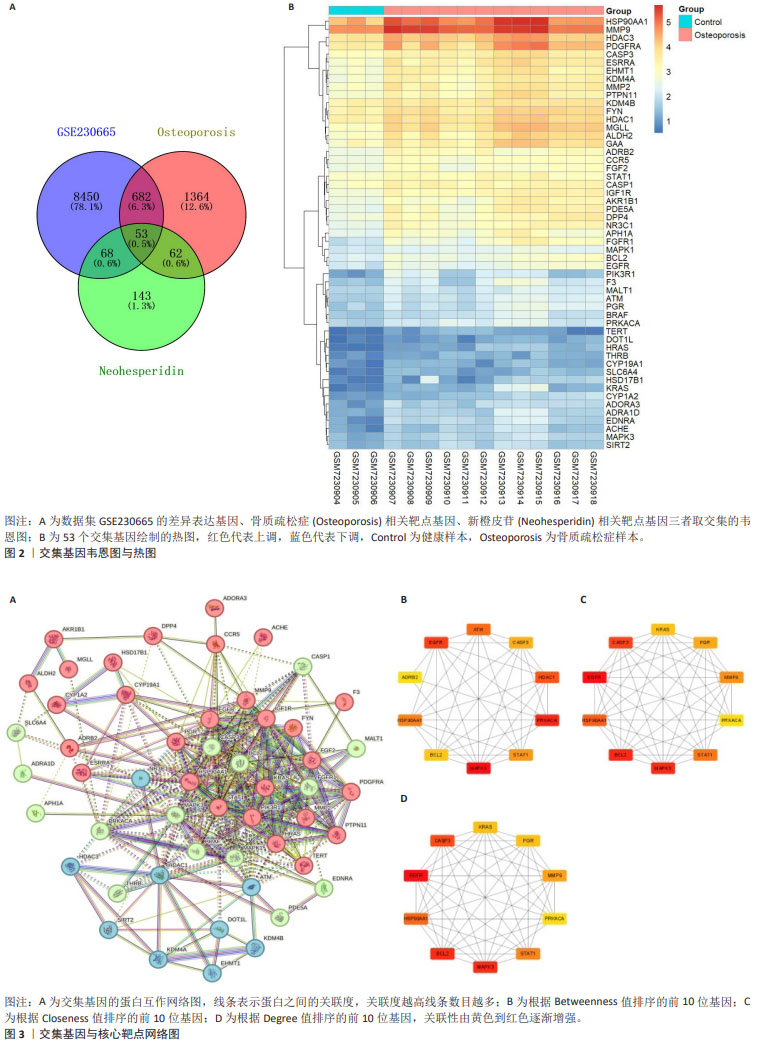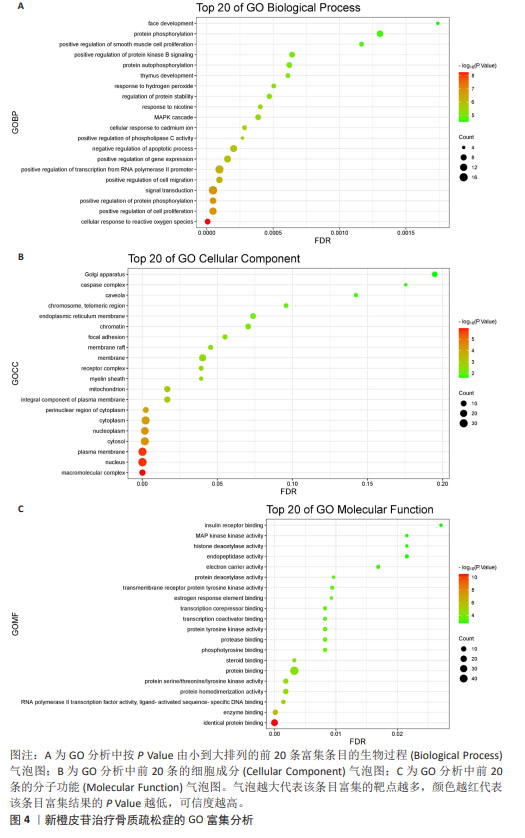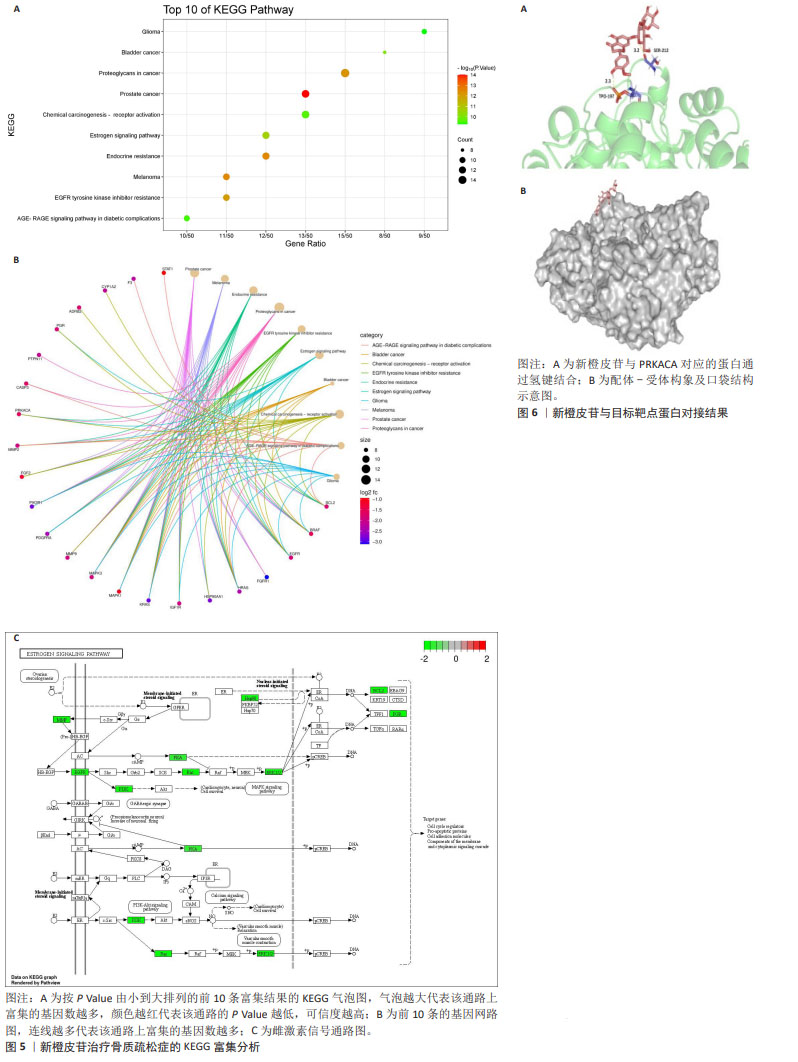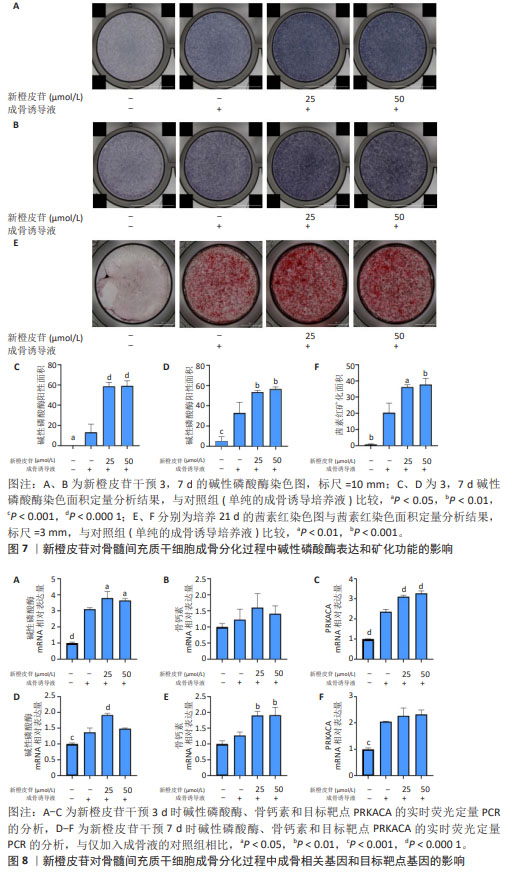[1] GAO S, ZHAO Y. Quality of life in postmenopausal women with osteoporosis: a systematic review and meta-analysis. Qual Life Res. 2023;32(6):1551-1565.
[2] ARMAS LA, RECKER RR. Pathophysiology of osteoporosis: new mechanistic insights. Endocrinol Metab Clin North Am. 2012; 41(3):475-486.
[3] YUAN S, ZHANG C, ZHU Y, et al. Neohesperidin Ameliorates Steroid-Induced Osteonecrosis of the Femoral Head by Inhibiting the Histone Modification of lncRNA HOTAIR. Drug Des Devel Ther. 2020;14:5419-5430.
[4] WANG XH, DAI C, WANG J, et al. Therapeutic effect of neohesperidin on TNF-α-stimulated human rheumatoid arthritis fibroblast-like synoviocytes. Chin J Nat Med. 2021;19(10):741-749.
[5] TAN Z, CHENG J, LIU Q, et al. Neohesperidin suppresses osteoclast differentiation, bone resorption and ovariectomised-induced osteoporosis in mice. Mol Cell Endocrinol. 2017;439:369-378.
[6] NOGALES C, MAMDOUH ZM, LIST M, et al. Network pharmacology: curing causal mechanisms instead of treating symptoms. Trends Pharmacol Sci. 2022;43(2):136-150.
[7] BARRETT T, WILHITE SE, LEDOUX P, et al. NCBI GEO: archive for functional genomics data sets--update. Nucleic Acids Res. 2013; 41(Database issue):D991-995.
[8] XIE L, FENG E, LI S, et al. Comparisons of gene expression between peripheral blood mononuclear cells and bone tissue in osteoporosis. Medicine (Baltimore). 2023;102(20):e33829.
[9] STELZER G, ROSEN N, PLASCHKES I, et al. The GeneCards Suite: From Gene Data Mining to Disease Genome Sequence Analyses. Curr Protoc Bioinformatics. 2016; 54:1.30.31-31.30.33.
[10] PIÑERO J, RAMÍREZ-ANGUITA JM, SAÜCH-PITARCH J, et al. The DisGeNET knowledge platform for disease genomics: 2019 update. Nucleic Acids Res. 2020;48(D1):D845-d855.
[11] ZDRAZIL B, FELIX E, HUNTER F, et al. The ChEMBL Database in 2023: a drug discovery platform spanning multiple bioactivity data types and time periods. Nucleic Acids Res. 2024;52(D1):D1180-D1192.
[12] UNIPROT CONSORTIUM. UniProt: the Universal Protein Knowledgebase in 2023. Nucleic Acids Res. 2023;51(D1):D523-d531.
[13] KIM S, CHEN J, CHENG T, et al. PubChem 2023 update. Nucleic Acids Res. 2023; 51(D1):D1373-d1380.
[14] DAINA A, MICHIELIN O, ZOETE V. SwissTargetPrediction: updated data and new features for efficient prediction of protein targets of small molecules. Nucleic Acids Res. 2019;47(W1):W357-w364.
[15] SZKLARCZYK D, KIRSCH R, KOUTROULI M,
et al. The STRING database in 2023: protein-protein association networks and functional enrichment analyses for any sequenced genome of interest. Nucleic Acids Res. 2023;51(D1):D638-d646.
[16] SHERMAN BT, HAO M, QIU J, et al. DAVID: a web server for functional enrichment analysis and functional annotation of gene lists (2021 update). Nucleic Acids Res. 2022;50(W1):W216-w221.
[17] TANG D, CHEN M, HUANG X, et al. SRplot: A free online platform for data visualization and graphing. PLoS One. 2023;18(11): e0294236.
[18] RU J, LI P, WANG J, et al. TCMSP: a database of systems pharmacology for drug discovery from herbal medicines. J Cheminform. 2014;6:13.
[19] TOYOTA A, GOTO M, MIYAMOTO M, et al. Novel protein kinase cAMP-Activated Catalytic Subunit Alpha (PRKACA) inhibitor shows anti-tumor activity in a fibrolamellar hepatocellular carcinoma model. Biochem Biophys Res Commun. 2022;621:157-161.
[20] Management of osteoporosis in postmenopausal women: the 2021 position statement of The North American Menopause Society. Menopause. 2021; 28(9):973-997.
[21] GOSSET A, POUILLÈS JM, TRÉMOLLIERES F. Menopausal hormone therapy for the management of osteoporosis. Best Pract Res Clin Endocrinol Metab. 2021;35(6):101551.
[22] PRESTWOOD KM, PILBEAM CC, RAISZ G. Treatment of osteoporosis. Annu Rev Med. 1995;46:249-256.
[23] BROWN JP. Long-Term Treatment of Postmenopausal Osteoporosis. Endocrinol Metab (Seoul). 2021;36(3):544-552.
[24] ZHANG ND, HAN T, HUANG BK, et al. Traditional Chinese medicine formulas for the treatment of osteoporosis: Implication for antiosteoporotic drug discovery. J Ethnopharmacol. 2016;189:61-80.
[25] LIU G, XIE Y, SU J, et al. The role of EGFR signaling in age-related osteoporosis in mouse cortical bone. Faseb J. 2019;33(10): 11137-11147.
[26] XIAO P, CHEN Y, JIANG H, et al. In vivo genome-wide expression study on human circulating B cells suggests a novel ESR1 and MAPK3 network for postmenopausal osteoporosis. J Bone Miner Res. 2008;23(5): 644-654.
[27] HU X H, YANG X Y, LIAN J, et al. Moringa oleifera leaf attenuate osteoporosis in ovariectomized rats by modulating gut microbiota composition and MAPK signaling pathway. Biomed Pharmacother. 2023;161:114434.
[28] VAKILI S, ZAL F, MOSTAFAVI-POUR Z,
et al. Quercetin and vitamin E alleviate ovariectomy-induced osteoporosis by modulating autophagy and apoptosis in rat bone cells. J Cell Physiol. 2021;236(5): 3495-3509.
[29] ZHU C, SHEN S, ZHANG S, et al. Autophagy in Bone Remodeling: A Regulator of Oxidative Stress. Front Endocrinol (Lausanne). 2022;13: 898634.
[30] FATOKUN AA, STONE TW, SMITH RA. Responses of differentiated MC3T3-E1 osteoblast-like cells to reactive oxygen species. Eur J Pharmacol. 2008;587(1-3):35-41.
[31] BĂDILĂ AE, RĂDULESCU DM, ILIE A, et al. Bone Regeneration and Oxidative Stress: An Updated Overview. Antioxidants (Basel). 2022;11(2):318.
[32] YAMAGUCHI Y, KANZAKI H, KATSUMATA Y, et al. Dimethyl fumarate inhibits osteoclasts via attenuation of reactive oxygen species signalling by augmented antioxidation. J Cell Mol Med. 2018;22(2):1138-1147.
[33] LEE J, SON HS, LEE H I, et al. Skullcapflavone II inhibits osteoclastogenesis by regulating reactive oxygen species and attenuates the survival and resorption function of osteoclasts by modulating integrin signaling. Faseb J. 2019;33(2):2026-2036.
[34] YE Y, ZHONG H, HUANG S, et al. Reactive Oxygen Species Scavenging Hydrogel Regulates Stem Cell Behavior and Promotes Bone Healing in Osteoporosis. Tissue Eng Regen Med. 2023;20(6):981-992.
[35] TURNHAM RE, SCOTT JD. Protein kinase A catalytic subunit isoform PRKACA; History, function and physiology. Gene. 2016; 577(2):101-108.
[36] JEONG JH, CHOI JY. Interrelationship of Runx2 and estrogen pathway in skeletal tissues. BMB Rep. 2011;44(10):613-618.
[37] CHENG CH, CHEN LR, CHEN KH. Osteoporosis Due to Hormone Imbalance: An Overview of the Effects of Estrogen Deficiency and Glucocorticoid Overuse on Bone Turnover. Int J Mol Sci. 2022; 23(3):1376.
[38] CUI J, SHEN Y, LI R. Estrogen synthesis and signaling pathways during aging: from periphery to brain. Trends Mol Med. 2013; 19(3):197-209.
[39] ALMEIDA M, IYER S, MARTIN-MILLAN M, et al. Estrogen receptor-α signaling in osteoblast progenitors stimulates cortical bone accrual. J Clin Invest. 2013;123(1): 394-404.
[40] CHEN D, PACE PE, COOMBES RC, et al. Phosphorylation of human estrogen receptor alpha by protein kinase A regulates dimerization. Mol Cell Biol. 1999;19(2): 1002-1015.
[41] HU HY, ZHANG ZZ, JIANG XY, et al. Hesperidin Anti-Osteoporosis by Regulating Estrogen Signaling Pathways. Molecules. 2023;28(19): 6987.
[42] NIU J, WANG Y, MENG Y, et al. Asperosaponin VI induces osteogenic differentiation of human umbilical cord mesenchymal stem cells via the estrogen signaling pathway. Medicine (Baltimore). 2022;101(50):e32344.
[43] KOBYLKA P, KUCINSKA M, KUJAWSKI J, et al. Resveratrol Analogues as Selective Estrogen Signaling Pathway Modulators: Structure-Activity Relationship. Molecules. 2022;27(20):6973.
[44] WANG L, SHAO YY, BALLOCK RT. Thyroid hormone interacts with the Wnt/beta-catenin signaling pathway in the terminal differentiation of growth plate chondrocytes. J Bone Miner Res. 2007; 22(12):1988-1995.
[45] SHARMA R, WU X, RHODES SD, et al. Hyperactive Ras/MAPK signaling is critical for tibial nonunion fracture in neurofibromin-deficient mice. Hum Mol Genet. 2013;22(23):4818-4828.
[46] CHEN T, WANG Y, HAO Z, et al. Parathyroid hormone and its related peptides in bone metabolism. Biochem Pharmacol. 2021; 192:114669.
[47] DIXIT M, POUDEL SB, YAKAR S. Effects of GH/IGF axis on bone and cartilage. Mol Cell Endocrinol. 2021;519:111052.
[48] ZHANG J, WANG X, DUAN H, et al. The Association of Calcium Signaling Pathway Gene Variants, Bone Mineral Density and Mild Cognitive Impairment in Elderly People. Genes (Basel). 2023;14(4): 828.
[49] VIMALRAJ S. Alkaline phosphatase: Structure, expression and its function in bone mineralization. Gene. 2020;754:144855.
[50] HAN Y, YOU X, XING W, et al. Paracrine and endocrine actions of bone-the functions of secretory proteins from osteoblasts, osteocytes, and osteoclasts. Bone Res. 2018;6:16. |




